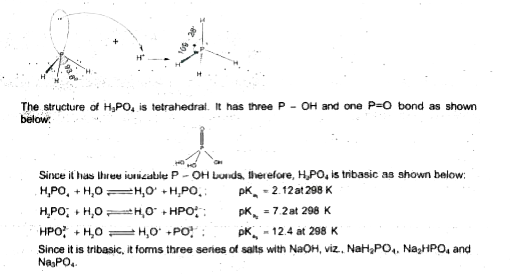How do you account for the reducing behaviour of H3PO2?
Why are pentahalides more covalent than Trihalides?
(iii) Bond angle in PH, is higher than that in PH3 Why?
(iv) What is the basicity of H3PO4?
Text Solution
(i)The structure of H3PO2 has two P-H bonds. Due to the presence of these P-H bonds, H3PO, acts as a strong reducing agent. For example, it reduces A educes AgNO3 to metallic Ag and arenediazonium salts to arenes.
4AgNO3+H3PO2+2H2O→4Ag+H3PO4+4HNO3
(ii)The elements of group 15 have five electrons (two in the s- and three in the p-orbitals) in their respective Valence shells. Since it is difficult to lose all the three electrons to form Eo or even more difficult to lose all the five valence electrons two S- and three p.) to E ions, therefore, higher elements have no tendency to form ionic compounds. Instead they form covalent compounds by sharing of electrons. Since elements in the +5 oxidation state have less tendency to lose electrons than in the +3 oxidation state, therefore elements in the +5 oxidation have more tendency to share electrons than in the +3 oxidation state. Thus, elements in the +5 oxidation state are more covalent than in the +3 oxidation state. In other words, pentahalides are more covalent than trihalides.
(iii)P in PH3 is sp -hybridized. It has three bond pairs and one lone pair around P. Due to stronger lone pair - bond pair repulsions than bond pair repulsions, the tetrahedral angle decreases from 109∘ - 28" to 93.6". As a result, PH3 is Pyramidal. However, when it reacts with a proton, it forms PH, ion which has four bond pairs and no lone pair. Due to the absence of lone pair - bond pair repulsions and presence of four identical bond pair - bond pair interactions, PH assumes tetrahedral geo-metry with a bond angle of 109∘−28.. This explains why the bond angle in higher than in PH3


|
Topper's Solved these Questions
- PREPARATION AND PROPERTIES OF COMPOUNDS AND GENERAL DISCUSSION OF S-AND P-BLOCK ELEMENTSBOOK - FIITJEECHAPTER - PREPARATION AND PROPERTIES OF COMPOUNDS AND GENERAL DISCUSSION OF S-AND P-BLOCK ELEMENTSEXERCISE - ASSIGNMENT PROBLEMS (SUBJECTIVE) LEVEL-I(short-Answer tpye question)
5 Videos
- PREPARATION AND PROPERTIES OF COMPOUNDS AND GENERAL DISCUSSION OF S-AND P-BLOCK ELEMENTSBOOK - FIITJEECHAPTER - PREPARATION AND PROPERTIES OF COMPOUNDS AND GENERAL DISCUSSION OF S-AND P-BLOCK ELEMENTSEXERCISE - ASSIGNMENT PROBLEMS (SUBJECTIVE) LEVEL-I(Give reasons: )
5 Videos
- PREPARATION AND PROPERTIES OF COMPOUNDS AND GENERAL DISCUSSION OF S-AND P-BLOCK ELEMENTSBOOK - FIITJEECHAPTER - PREPARATION AND PROPERTIES OF COMPOUNDS AND GENERAL DISCUSSION OF S-AND P-BLOCK ELEMENTSEXERCISE - SINGLE INTEGER ANSWER TYPE QUESTIONS
2 Videos
- PERIODIC PROTERTIES OF ELEMENTSBOOK - FIITJEECHAPTER - PERIODIC PROTERTIES OF ELEMENTSEXERCISE - COMPREHENSION
13 Videos
- QUALITATIVE ANALYSIS BOOK - FIITJEECHAPTER - QUALITATIVE ANALYSIS EXERCISE - Single interger answer type
3 Videos
Similar Questions
Knowledge Check
Strong reducing behaviour of H3PO2 is due to
ALow oxidation state of phosphorusBPresence of two - OH groups and one P-H bondCPresence of one - OH group and two P-H bondsDHigh electron gain enthalpy of phosphorusStrong reducing behaviour of H3PO2 is due to
Alow oxidation state of phosphorusBpresence of two-OH groups and one P-H bondCpresence of one-OH group and two P-H bondsDhigh electron gain enthalpy of phosphorus
Bond angle in PH+4 is higher than that in PH3.Why ?
View SolutionBond angle in PH+4 is higher than that in PH3.Why ?
View SolutionBond angle in PH+4 is higher than that in PH3.Why ?
View SolutionBond angle in PH+4 is higher than that in PHz. Why?
View SolutionHow do you account for reducing behaviour of H3PO2 on the basis of its structure?
View SolutionHow do you account for reducing behaviour of H3PO2 on the basis of its structure?
View Solution
